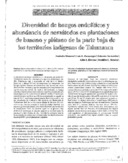| dc.contributor.advisor | Rosales, Franklin E. | es_ES |
| dc.contributor.author | Meneses, Anabella | es_ES |
| dc.contributor.author | Pocasangre, Luis E. | es_ES |
| dc.contributor.author | Somarriba, Eduardo | es_ES |
| dc.contributor.author | Riveros, Alba S. | es_ES |
| dc.contributor.other | CATIE - Centro Agronómico Tropical de Investigación y Enseñanza | |
| dc.date.accessioned | 2015-03-19T21:19:25Z | |
| dc.date.available | 2015-03-19T21:19:25Z | |
| dc.date.issued | 2003 | |
| dc.identifier | 466901 | es_ES |
| dc.identifier.issn | 1022-7482 | es_ES |
| dc.identifier.uri | https://repositorio.catie.ac.cr/handle/11554/6077 | |
| dc.description | 1 figura, 3 tablas,16 ref. | es_ES |
| dc.description.abstract | La diversidad de hongos endofíticos y la abundancia de nematodos (Radopholus similis (R),Helicotylenchus spp.(H),Meloidogyne spp . (M),Pratylenchus spp. y nemátodos de vida libre)en banano (BanCon)y plátano (PlCon)convencionales fue comparado con banano orgánico (banano en monocultivo (B),banano con cacao (B+C),banano con cacao y especies forestales (B+C+F)y banano con especies forestales (B+F)).Un total de 123 morfotipos de hongos endofíticos fueron aislados de los sistemas orgánicos, presentándose la mayor riqueza en B+F y la menor en el sistema B (68 y 33 morfotipos, respectivamente).En BanCon y PlCon convencionales se registró un total de 39 y 31 morfotipos, respectivamente. BanCon presentó la más alta abundancia de morfotipos (208 aislados),con dominancia de Trichoderma. B +F fue el más diverso (Índice de Shannon H=3,78) mientras que BanCon presentó la menor diversidad (H=3,04).Los sistemas agroforestales presentaron mayor diversidad que los sistemas de monocultivo. Entre los sistemas orgánicos, se presentó baja similitud de morfotipos la más alta similitud se encontró entre los sistemas B y B+C (Índice de Dice,D=0,48).La población total de fitonemátodos en plantaciones convencionales fue significativamente mayor (p menor igual que 0,001) que en plantaciones orgánicas. | es_ES |
| dc.description.abstract | Diversity of endophytic fungi and nematode abundance (Radopholus similis (R),Helicotylenchus spp.(H),Meloidogyne spp. (M),Pratylenchus spp.and free living nematodes)in conventional banana (Bancon)and plantain (PlCon)was compared with organic banana (monoculture banana -B-),banana with cacao (B+C), banana with cacao and timber species (B+C+F),banana with timber species (B+F)).A total of 123 morphotypes of endophytic fungi were isolated from the organic systems B+F presented the highest value, while B had the lowest number (68 and 33,respectively).In Bancon and PlCon,39 and 31 morphotypes were registered, respectively. BanCon had the highest abundance of morphotypes (208 isolates), with dominance of Trichoderma. B+F was the most diverse (Shannon index H=3.78 ),whereas BanCon was least diverse (H=3.04). Agroforestry systems were more diverse than monocultures. The organic systems had low similarity of morphotypes the highest similarity was found between B and B+C (Dice Index,D=0.48).The total population of phytonematodes in conventional banana plantations was significatively higher (p minor equal than 0.001)than in organic production systems. | en_US |
| dc.language.iso | es | es_ES |
| dc.publisher | CATIE, Turrialba (Costa Rica) | es_ES |
| dc.relation.ispartof | Agroforestería en las Américas Volumen 10, números 37-38 (2003), páginas 59-62 | es_ES |
| dc.rights | info:eu-repo/semantics/openAccess | es_ES |
| dc.subject | MUSA (BANANOS) | es_ES |
| dc.subject | MUSA (PLATANOS) | es_ES |
| dc.subject | NEMATODOS DE LAS PLANTAS | es_ES |
| dc.subject | HONGOS | es_ES |
| dc.subject | AGROFORESTERIA | es_ES |
| dc.subject | AGRICULTURA ORGANICA | es_ES |
| dc.subject | AGRICULTURA TRADICIONAL | es_ES |
| dc.subject | COSTA RICA | es_ES |
| dc.subject.other | Sede Central | |
| dc.title | Diversidad de hongos endofíticos y abundancia de nemátodos en plantaciones de banano y plátano de la parte baja de los territorios indígenas de Talamanca | es_ES |
| dc.title.alternative | Diversity of endophytic fungi and nematode ahundance in banana and plantain plantantions in the ingenous lowland territories in Talamanca | |
| dc.type | Artículo | es_ES |


